Editor’s Morning Note: Strap on your nerd pants.
 We’re running low on money gifs, people.
We’re running low on money gifs, people.
The other week, Samuel Gil, a partner at JME Ventures, wrote a piece entitled “Meaningful VC Exits,” detailing the math behind how a venture fund makes money.
It’s worth reading in its entirety, but I wanted to highlight something from Gil’s effort that impacts our regular work here: The varying value of revenue.
Gil does a good job explaining the connection between revenue, revenue quality, and resulting valuation. What the hell does that all mean? Great question.
Revenue Metrics
Gil’s work is designed to help founders, employees, and aspiring investors understand the relative scale required for a startup exit to be meaningful to a venture fund.
The piece shows how larger funds require far bigger exits for them to “count.” Along the way, however, Gil draws up a short price sheet of what various hypothetical startups’ revenue results are worth.
It’s lovely:

Gil then follows up with a note to his menu, which brings us to our core topic:
Margins

In case that point isn’t entirely clear, let’s afford ourselves a quick translation:
- A startup that sells software as a service (SaaS) that costs 25 percent of top line to produce is worth five times its annual recurring revenue (ARR).
So if your SaaS firm with 75 percent gross margins had $5 million in the last quarter, it’s worth $100 million by this rubric.
- A startup that maintains a marketplace in which it collects 15 percent of dollars passing through can sell for one times the amount of money that passed through its platform in the last year.
A marketplace startup that collects an average of 15 percent of dollars spent on its platform that saw $100 million of activity will have revenue of $15 million, and a value of $100 million.
- A startup that sells goods online that cost 30 percent of revenue to produce can sell for two times its last twelve month revenues.
An ecommerce startup that keeps 70 percent of its revenue as gross profit that did $50 million in revenue in the last twelve months is worth $100 million.
I am sure you are annoyed by the simplicity of this exercise. That’s reasonable. But take the path we just walked as illustrative of the point that not all revenue is equal.
In that vein, the more profitable a dollar of revenue is, the more money it is worth. At least over time. But there are times when more dollars in revenue are more important than improving revenue quality from a valuation perspective, but we can blame Sand Hill for that.
All this is to note that when we discuss the changing value of ARR or revenue multiples at other companies, including the gross margins of the cloud titans, we are discussing revenue quality.
Gil’s Rectangles
Our own thought experiment aside, let’s give Gil the last word on mental work.
Here’s his chart discussing, from left to right, the size of a hypothetical venture fund, the size of an exit (gross) required for it to be “meaningful” to the fund’s returns, and then revenue targets required for an exiting startup of the various categories to hit that mark.

Homework: Draw up your own method for valuing startups. Do you value ARR more than Gil? Is his marketplace GMV multiple too rich?